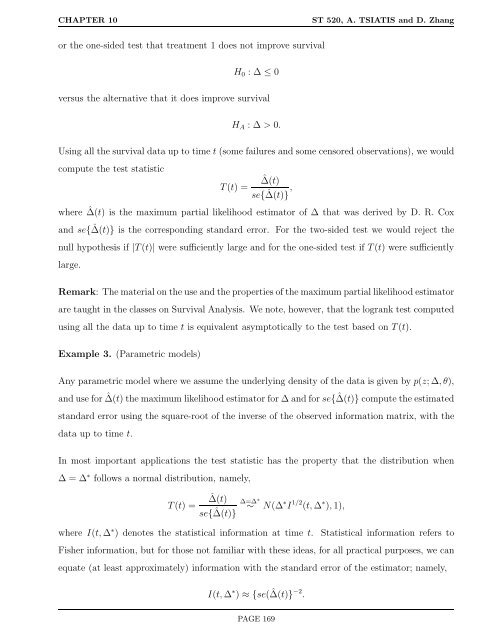ST 520 Statistical Principles of Clinical Trials - NCSU Statistics ...
ST 520 Statistical Principles of Clinical Trials - NCSU Statistics ...
ST 520 Statistical Principles of Clinical Trials - NCSU Statistics ...
Create successful ePaper yourself
Turn your PDF publications into a flip-book with our unique Google optimized e-Paper software.
CHAPTER 10 <strong>ST</strong> <strong>520</strong>, A. TSIATIS and D. Zhang<br />
or the one-sided test that treatment 1 does not improve survival<br />
H0 : ∆ ≤ 0<br />
versus the alternative that it does improve survival<br />
HA : ∆ > 0.<br />
Using all the survival data up to time t (some failures and some censored observations), we would<br />
compute the test statistic<br />
T(t) = ˆ ∆(t)<br />
se{ ˆ ∆(t)} ,<br />
where ˆ ∆(t) is the maximum partial likelihood estimator <strong>of</strong> ∆ that was derived by D. R. Cox<br />
and se{ ˆ ∆(t)} is the corresponding standard error. For the two-sided test we would reject the<br />
null hypothesis if |T(t)| were sufficiently large and for the one-sided test if T(t) were sufficiently<br />
large.<br />
Remark: The material on the use and the properties <strong>of</strong> the maximum partial likelihood estimator<br />
are taught in the classes on Survival Analysis. We note, however, that the logrank test computed<br />
using all the data up to time t is equivalent asymptotically to the test based on T(t).<br />
Example 3. (Parametric models)<br />
Any parametric model where we assume the underlying density <strong>of</strong> the data is given by p(z; ∆, θ),<br />
and use for ˆ ∆(t) the maximum likelihood estimator for ∆ and for se{ ˆ ∆(t)} compute the estimated<br />
standard error using the square-root <strong>of</strong> the inverse <strong>of</strong> the observed information matrix, with the<br />
data up to time t.<br />
In most important applications the test statistic has the property that the distribution when<br />
∆ = ∆ ∗ follows a normal distribution, namely,<br />
T(t) = ˆ ∆(t)<br />
se{ ˆ ∆=∆<br />
∆(t)}<br />
∗<br />
∼ N(∆ ∗ I 1/2 (t, ∆ ∗ ), 1),<br />
where I(t, ∆ ∗ ) denotes the statistical information at time t. <strong>Statistical</strong> information refers to<br />
Fisher information, but for those not familiar with these ideas, for all practical purposes, we can<br />
equate (at least approximately) information with the standard error <strong>of</strong> the estimator; namely,<br />
I(t, ∆ ∗ ) ≈ {se( ˆ ∆(t)} −2 .<br />
PAGE 169
















